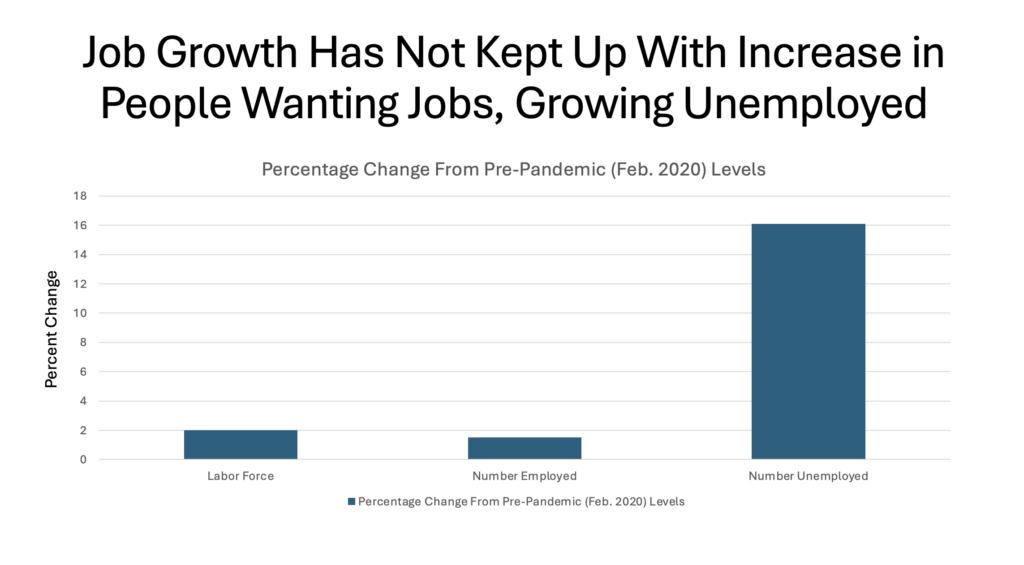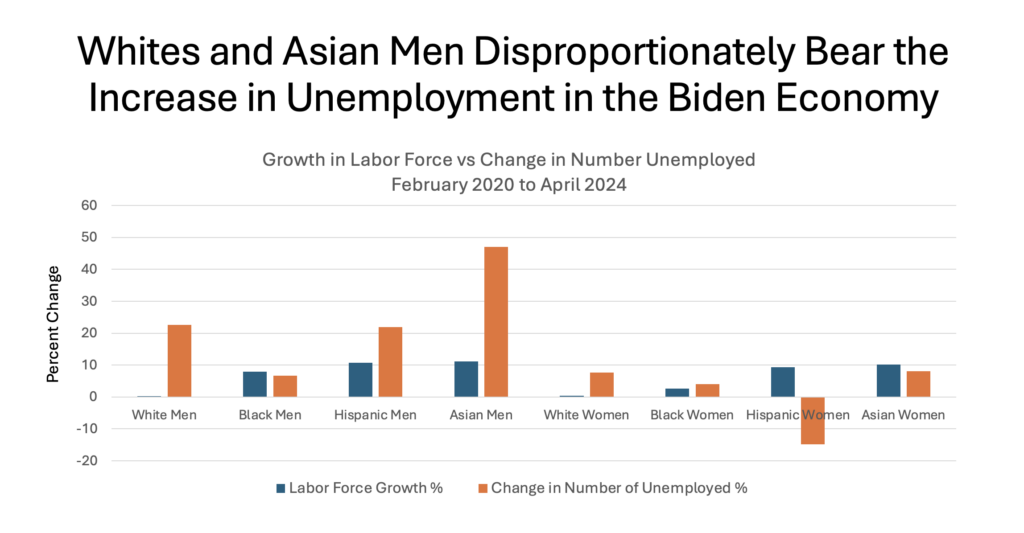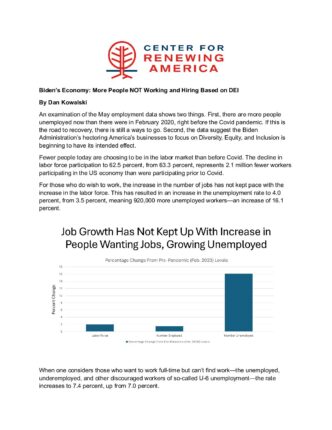
Biden’s Economy: More People NOT Working and Hiring Based on DEI
An examination of the May employment data shows two things. First, there are more people unemployed now than there were in February 2020, right before the Covid pandemic. If this is the road to recovery, there is still a ways to go. Second, the data suggest the Biden Administration’s hectoring America’s businesses to focus on Diversity, Equity, and Inclusion is beginning to have its intended effect.
Fewer people today are choosing to be in the labor market than before Covid. The decline in labor force participation to 62.5 percent, from 63.3 percent, represents 2.1 million fewer workers participating in the US economy than were participating prior to Covid.
For those who do wish to work, the increase in the number of jobs has not kept pace with the increase in the labor force. This has resulted in an increase in the unemployment rate to 4.0 percent, from 3.5 percent, meaning 920,000 more unemployed workers—an increase of 16.1 percent.

When one considers those who want to work full-time but can’t find work—the unemployed, underemployed, and other discouraged workers of so-called U-6 unemployment—the rate increases to 7.4 percent, up from 7.0 percent.
Looking further at the demographics of the latest unemployment report, we find that there is a large increase in male unemployment rate relative to female workers, and profound differences in outcomes by race that are strikingly consistent with the Biden Administration’s push for DEI hiring policies.

The number of unemployed men increased by 701,000 (23.1 percent) relative to pre-pandemic levels in February 2020, increasing the male unemployment rate to 4.2 percent from 3.5 percent. The increase in unemployment was not uniform across racial and ethnic demographics.
- White male unemployment increased to 3.7 percent from 3.1 percent
- The 22.6 percent increase (471,000) in unemployed white males greatly surpasses the 0.2 percent increase in white male labor force (Other things being equal, the increase in the number of unemployed would be roughly the same as the increase in the labor force.)
- Black male unemployment stayed flat at 6.8 percent
- This reflects a 6.7 percent increase (45,000) in unemployed compared with a 7.9 percent increase in labor force
- Hispanic male unemployment increased to 4.8 percent from 4.3 percent
- 21.9 percent increase (158,000) in unemployed compared with a 10.7 percent increase in labor force (note that citizenship is not asked in the BLS’ household survey).
- Asian male unemployment increased to 2.9 percent from 2.1 percent
- This reflects a 47.1 percent increase (57,000) compared with a 11.2 percent increase in the labor force.
The number of unemployed women increased by 219,000, increasing the unemployment rate to 3.7 percent, from 3.5 percent. Female unemployment went up for every census demographic except Hispanic.
- White female unemployment increased to 3.2 percent from 3.0 percent
- This reflects a 7.6 percent increase (135,000) in unemployed compared with a 0.4 percent increase in the labor force.
- Black female increased to 5.5 percent from 5.4 percent
- This reflects a 4 percent increase (24,000) increase in unemployed coupled with a 2.6 percent increase in labor force
- Hispanic female unemployment decreased to 4.3 percent from 5.5 percent
- 14.8 percent decrease (-106,000) in unemployed compared with a 9.3 percent increase in labor force
- Asian female unemployment decreased to 2.9 percent from 3.0 percent, but the number of unemployed increased
- 8.1 percent increase (12,000) compared with a 10.2 percent increase in the labor force
The data suggest that it is currently difficult for white and Asian workers to find employment. It appears somewhat easier for black males but has become more difficult for black females. The rapid increase in the Hispanic male labor force makes it slightly harder for that group to find work, while it is currently relatively easier for Hispanic women to find employment. This disproportionate hiring pattern perhaps reflects the Biden Administration’s immigration policies and emphasis on DEI principles.




